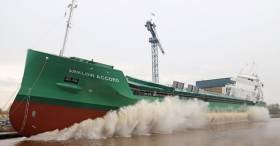Displaying items by tag: Almost 60 ships
Arklow C-Class Cargoship Launched During Dull Skies Yet 'Cloud' Rises Fleet to Almost 60 Ships
Despite dull skies, a spectacular launch took place at a Dutch shipyard this morning of Arklow Shipping's latest newbuild which increases the fleet total to 58 cargoships, writes Jehan Ashmore
The single-hold newbuild Arklow Cloud, a name used for the first time by the Co. Wicklow shipowners, took to the waters with a splash. Such a sight is routine at Ferus Smit's Westerbroek shipyard, yet is always a sight to behold.
Albeit the launch due to pandemic was executed without ceremony and nor open to the public, however spectators could observe the event from the opposite side of the ‘Winschoterdiep’ canal.
As routine at this side of the canal (in the province Groningen) the road is closed off to traffic and pedestrians as the wash from the ship spills over the roadside and runs off down an embankment.
With a yard newbuild number of NB 430, Arklow Cloud also represents the seventh so far in a series of 10 ships of the 'C' class general cargoships built an the inland yard and to a new design ordered for ASL. The combined fleet including Dutch-flagged tonnage as alludded is just shy of sixty ships operating mostly in Europe but also several bulkers trading globally in deep seas.
Arklow Cloud has a maximized hold volume of 220.000 cft and a carrying capacity over 5,000 deadweight tons (dwt) yet it still falls under the 3,000 gross tons limit. The ship's single hold within a hull of almost 88m is specified to an 1A ice-class notation.
A bulbless bow design provides for a superior performance when operating between various loading drafts and wave-height conditions
Among the typical cargoes will be the transportation of corn, grain, wheat and other bulk commodities in European waters from where propulsion of the 2,999 grt newbuild will involve a 1,740kW MaK engine with a single ducted propeller.
Likewise of the series in service, Arklow Cloud will be Irish flagged and already displays the homeport of Arklow proudly at the stern from where the tug Waterpoort was on station during the amidships launch.
While another red hulled tug attended the ship's bow complete with customary green hull colour associated with Ireland's only large shipowner.
A New Accord Brings Further Expansion of Arklow Shipping Fleet
Arklow Accord is the latest of a new series for ship-owner Arklow Shipping Ltd, however the bulk oriented cargo vessel is also a first for the company to use this ship name, writes Jehan Ashmore.
The launching of newbuild Arklow Accord (Nb. 438) which took place on Friday, represents the second of a six ships using the Arklow 'A' naming scheme. The order by ASL is with shipbuilder Ferus Smit at their Dutch shipyard located in Westerbroek.
Currently the company have almost 60 vessels including Dutch division Arklow Shipping Nederland B.V. and this milestone is to be exceeded with the roll-out of the Arklow A - series.
The design of Arklow Accord will see its operations chiefly employed in the shipment of corn, wheat and other bulk commodities in European waters.
The inland yard at Westerbroek, is where Irish flagged leadship Arklow Abbey was also given the customary launched sideways in July and with the newbuild entering service two months later.
According to Ferus Smit, the design is a slightly modified version of the first series of 8600dwt bulkers that the shipyard built under the Arklow B – series. The new design is adapted for iceclass 1A, with modified bow form and propulsion with a propeller nozzle added.
At the same time, the main engine output was decreased to 2000 kW for better fuel efficiency.
Listed below are the basic characteristics of Arklow Accord:
– Loa = 119.495 mtr
– Lpp = 116.895 mtr
– B = 14.99 mtr
– D = 9.70 mtr
– T max = 7.160 mtr
– Hold volume = 350.000 cft
The delivery of the Arklow registered newbuild is due for January 2020.






























































